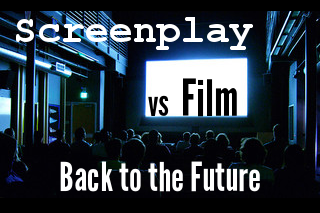Iam really excited about this week’s Screenplay vs Film selection: Back to the Future, the 1985 classic starring Michael J Fox & Christopher Lloyd and written by Robert Zemeckis & Bob Gale. I used to watch this movie over and over again as a kid, and I thought it’d be interesting to analyze it from a screenwriting perspective. It’s also one of the screenplays that Scott Myers over at Go Into the Story recommends every aspiring screenwriter should read, and that also piqued my interest.
It holds up really well – a little over 25 years later and it’s still as enjoyable as I remembered. I don’t care what film school says. For me, that’s the defining characteristic of a really great movie.
I found two versions of the screenplay, one from 1981 and one from 1985. The 1985 version was basically the shooting script, so I stopped reading it, and started reading the 1981 version. Comparing the 1981 draft to the movie yielded a goldmine of screenwriting tips, so it’s a great addition to the Screenplay vs Film series.
If you’re familiar with the Screenplay vs Film feature of Scribe Meets World, skip this paragraph and head on straight to the screenwriting tips. If you’re new to the site, welcome! Here’s what Screenplay vs Film is all about: one of the best ways to hone your screenwriting skills is to compare a screenplay to its resulting movie. If you don’t have time for this, don’t worry. I’m going to post the screenwriting tips I learned by doing exactly that. And on Thursdays, I’m going to post a list of plot points from the movie I analyzed. If you study these plot points, you should strengthen your understanding of screenwriting structure and pacing.
And onto the screenwriting tips from Back to the Future:
Screenwriting Tip #1: Create intrigue with your introduction
In the 1981 screenplay, this is how we meet Marty McFly and Doc Brown in the very first scene: Marty’s making VHS bootlegs of popular sci-fi movies, while Doc is trying to harness the power of the sun with a primitive solar cell.
I was really disappointed with this intro because I didn’t like the idea of Marty being a small-time crook. It just rubbed me the wrong way. This is followed by Doc talking about solar power — a lengthy bit of of boring exposition. Finally, there’s a locked room in Doc’s lab. Regarding the room, Marty tells Doc, “one of these days, I’m going to find out what’s in there.” A few scenes later, we learn that Doc’s been storing a time travel device in it — and it isn’t the DeLorean we all love and remember. It just seemed to be such a hokey way to introduce the centerpiece of your movie (more on that in the next screenwriting tip).
Contrast this with the way the 1985 movie begins:
- An assortment of clocks tick away at Doc Brown’s lab
- A tv news report informs us that plutonium has been stolen from a research facility
- Several inventions operate in sequence. One is a robotic arm can opener which empties a can of dog food into a dish already overflowing with uneaten morsels
- Marty enters on his skateboard. It slides underneath a bed — next to a box of plutonium
- He amps up his guitar. It blows out and knocks him over
- Doc calls and asks Marty to meet him at 1:05 AM at Twin Pines mall
This has got to be one of the best movie beginnings ever (although my sparse description doesn’t do it justice). I was hooked right away. I love how intriguing it is — with barely a line of dialogue. I read somewhere that David Mamet, acclaimed playwright and writer-director, thinks all screenplays should be written with the least amount of dialogue possible…and that if you read only the action/description of a screenplay, it should tell a complete story.
As a fan of “talky” pictures such as When Harry Met Sally, I don’t know if I agree with that. Also, there are rumors that Hollywood executives sometimes only read the dialogue in a screenplay and skip everything else. So if you had only a little dialogue, they wouldn’t be reading much! Nevertheless, I think Mamet’s idea is an interesting one. The intro of Back to the Future adopts this principle — and it really paid off.
When you’re writing your own movie, ask yourself if the beginning of your screenplay has the same energy and intrigue as Back to the Future’s. If it has even half of that, you’re on the right track! If it doesn’t, try to see what’s slowing down your screenplay. The most likely culprit is too much exposition.
Screenwriting Tip #2: Introduce your cool gadget in style
Back the Future is a time travel adventure, so the device that enables the time traveling is going to be a star attraction. Because of this, the time traveling device should be introduced with flair and panache.
In the 1981 screenplay draft, this is what happens:
INT. THE “LOCKED” ROOM
Professor Brown is standing next to a HOMEMADE NUCLEAR REACTOR, made from an old furnace, a hot water heater, and boiler room parts. He has one hand on a rope, and is adjusting some dials and gauges.
SHEMP is sitting quietly on a stool directly under the focusing lens of the Professor’s invention. He’s wearing his organ grinder clothes, with a digital watch around his neck.
MARTY
Professor!
The Professor, although surprised to see Marty, is in command of the situation.
PROF. BROWN
Get behind that lead shield!
He points to the shield at one side of the room.
MARTY
But Professor—
PROF. BROWN
Get behind the shield! I’m about to release radiation!
Marty hurries behind the shield.
Professor Brown pulls the rope ever so slightly.
The Power Converter is activated! The low frequency hum of vacuum tubes becomes more intense—the frequency begins to rise, accompanied by the crackle of static electricity!
Shemp looks around, curious about all of these sounds…the sounds grow in intensity…tension builds…and at exactly 9:00, Professor Brown releases the rope. At that moment, a high frequency tone is emitted, accompanied by a FOCUSED BEAM OF BLINDING RED LIGHT—like a spotlight—which hits Shemp!
Shemp DISAPPEARS! And the top half of the stool disappears with him, leaving the lower halves of the legs (which were not hit by the beam) to topple to the floor!
Air rushes through the lab to fill the vacuum that was created by Shemp’s disappearance!
The sound of the equipment dies down, and a stunned Marty McFly steps out from behind the shield.
Okay, so making Shemp, an organ-grinding monkey, the first time traveler is not that bad of an introduction. But it’s not on the same level as what happens in the movie.
One reason the movie version is more satisfying is that the DeLorean is much more appealing than a beam of red light hidden in a closet. The DeLorean is a stroke of genius–one that took several screenplay drafts to discover.
The odds are high that your screenplay doesn’t have a time traveling device, but it might have some physical element that plays a key role in the plot. If that’s the case, brainstorm several possible ways to introduce this element, and then choose the best one.
Note: you don’t have to spend a lot of lines describing the physical features of the element. The best introductions don’t!
Screenwriting Tip #3: Don’t overuse exclamation points
In the above excerpt, there are several exclamation points! Believe me there are several more in the screenplay! One day, I might even count them to shock you with their sheer abundance! It’s very tempting to use exclamation points, especially when a character is angry or thrilled or when there’s an exciting action sequence!

Don’t over use me, please
But when you’re writing your own movie, try to restrain yourself because it’s very annoying and gives your screenplay a childish quality. Have confidence that you’ve chosen the right words in your dialogue and described the context well enough so that a reader can see and hear the energy and excitement in their mind without resorting to exclamation points. The period is a humble, but very worthy, punctuation mark.
Screenwriting Tip #4: Make your Act breaks sizzle
In both the 1981 screenplay and the 1985 movie, the Act I break occurs when Marty accidentally time travels from 1985 to 1955. But the way they occur is significantly different. (The first act break is only one essential plot point. For the other seven, read 8 Major Plot Points every movie outline should have.)
In the 1981 screenplay, Doc Brown is about to send his monkey back in time a second time, when he’s interrupted by federal agents who tell Doc to shut down his reactor. When he doesn’t, they shoot him in the chest. Marty rushes to him, gets in the way of the time travel device, and is accidentally sent back in time.
In the movie, Doc Brown’s time traveling DeLorean is fueled by plutonium — which he’s stolen from Libyans. When the Libyans arrive at the Twin Pines parking lot in their ridiculously small VW van, they shoot Doc Brown and chase Marty. Marty jumps into the DeLorean to escape them, then accelerates and maneuvers around the parking lot. When he reaches 88 mph, he’s transported to 1955.
While the two versions are similar, the movie version sizzles with action and energy. It took me awhile to figure out why. Then I finally realized the screenplay version felt confined since all the action occurred in one room.
There have been great scenes in dramas and thrillers that take place in one room. But more often than not, scenes have more sizzle when they occur in different locations or in larger spaces (like the Twin Pines parking lot).
If the action in one of your set piece sequences seems a little dull, see if you can enhance the action by widening the scope of the scene — if it takes place in one room, have it spread to other rooms in a house or alternately, take it outside.
Screenwriting Tip #5: Put a lid on your personal agenda
In the 1981 screenplay draft, when Marty was transported to 1955, he sat in on a science class. He has the following exchange with his teacher:
MR. ARKY
You’re the only Mr. Lewis in this class. If you have something to say, say it so the whole class can hear.
MARTY
Well, yeah, I was thinking, if cars are gonna be going 2 or 300 miles an hour, they’re gonna be using an awful lot of gas. Like, what if we run out?
MR. ARKY
Run out of gas?
He reacts as if it’s the most ridiculous thing he’s ever heard. There is laughter from the class.
MR. ARKY
Well, class, it seems we have a doomsayer in our midst. I must say, Mr. Lewis, that’s a mighty pessimistic attitude for a young man like yourself. First of all, with all the studies we have indicating the vast supplies of petroleum in the earth, plus the massive reserves that have yet to be discovered, the likelihood of any such shortage is highly remote. And even if the most improbable, catastrophic circumstances were to occur and we did have a shortage of petroleum, I’m sure that American technology and ingenuity would overcome the problem in no time at all. All in all, I’d say your time would be better spent worrying about the real problems that face our world instead of a shortage of gasoline.
Biff and his boys make FART NOISES.
BIFF
Hey, we got plenty of gas back here!
More LAUGHTER from the class.
This bit of dialogue, or should I say far-too-lengthy monologue, brought the screenplay to a screeching halt. Thankfully, it didn’t end up in the movie. When I was reading it, it seemed like Zemeckis and Gale wanted to give the audience a lesson in fossil fuels and their future depletion and completely forgot about their storytelling. If you do have some personal message that you want to incorporate in your screenplay, make sure you do just that: incorporate it. Don’t dump all of your talking points into a speech delivered by one character. For an example of doing it right, read tip #6 in 10 Screenwriting Tips from RED (Part 2).
Screenwriting Tip #6: Patience = Paydirt
It took four years for Zemeckis & Gale to transform their 1981 screenplay into the 1985 gem it evolved into. Granted, their 1981 screenplay had a high concept, solid structure, and clever one-liners and set pieces (which remained in the 1985 movie). But the 1985 movie takes that solid foundation, expands upon it and adds a DeLorean to the mix, yielding a classic that’s entertaining to watch even now.
Before Zemeckis made Back to the Future, he directed Romancing the Stone. The unexpected success of Romancing the Stone enabled Zemeckis to direct his passion project Back to the Future. Before that however, Back to the Future was rejected by every studio in town. I can understand rejecting the 1981 screenplay, although I’m surprised they didn’t realize the potential of its high concept idea. But the 1985 draft — that should’ve knocked off the socks of every executive in town.
The whole point of the Screenplay vs Film series is for you to learn screenwriting tips by comparing the screenplay and film versions of a movie–without having to do the watching and the reading yourself. In this instance however, I highly recommend that you track down the 1981 draft of Back to the Future and compare it to the movie.
I suggest you do this, not just because you may discover even more screenwriting tips, but also because most of us rush to send out our screenplays when we’ve completed them instead of taking the time to really polish them and hone down our ideas.
Sometimes that’s because we’re impatient. Other times, it’s because we think our screenplay is so fantastic, we can’t make it any better. If the latter describes you, read the 1981 draft of Back to the Future and ask yourself if your current screenplay is more like Back to the Future 1981 or like Back to the Future 1985. If it’s like the 1981 version, spend more time polishing your screenplay. Don’t despair though, because you’re really close to something fantastic. If your version is more like the 1985 movie, work every possible angle to get your screenplay into the right hands!
Final thoughts
I hope that everyone can’t get enough of these screenwriting tips because I’m going to post more of them tomorrow! Also, I’d love to hear your suggestions for screenplays/films to analyze in this Writing for Movies: Screenplay vs. Film series.
Watching a blank screen (with modifications) by Kenneth Lu





















Comments on this entry are closed.
Hi Mr’s Scribe 🙂
I’m not sure if you have seen it but another movie with an incredible opening with no dialogue is “There will be blood” with Daniel Day Lewis.
Bruce,
I don’t think I have the patience for a 2 1/2 hour historical epic, especially since PTA alienated me with Punch Drunk Love. But maybe now, I’ll check it out, and I’m sure other readers appreciate the recommendation!
This site is invaluable! Thanks for a lot of worthwhile reading!